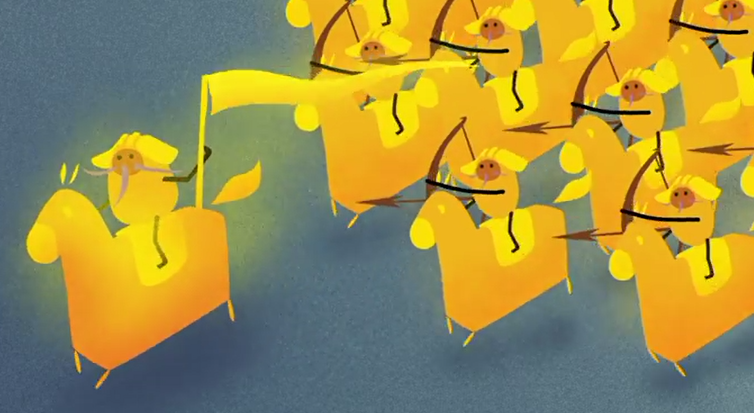With Vladimir's conversion and marriage to the Byzantine emperor's sister, as well as continued trade along the Volga route, the relationship between the two civilizations deepened.
通過弗拉米爾的轉變,還有他和拜占庭皇妹的聯姻以及伏爾加河上蓬勃發展的貿易,兩個帝國的關系更加緊密了。
Byzantine missionaries created an alphabet for Slavic languages based on a modified Greek script while Rus Viking warriors served as the Byzantine Emperor's elite guard.
羅斯帝國的維京戰士在拜占庭帝國做一流守衛的同時,拜占庭的傳教士根據改良版的希臘字母為斯拉夫語創造了一套新的字母表。

For several generations, the Kievan Rus flourished from its rich resources and trade.
在很長一段時間后,基輔羅斯由于自身豐富的資源和蓬勃發展的貿易變得十分強大。
Its noblemen and noblewomen married prominent European rulers, while residents of some cities enjoyed great culture, literacy, and even democratic freedoms uncommon for the time.
他們的貴族在與歐洲其他統治者聯姻的同時,當地居民還享受著他們自己偉大的文化、文學甚至是當時罕有的民主自由。
But nothing lasts forever.
但是好景不長。
Fratricidal disputes over succession began to erode central power as increasingly independent cities ruled by rival princes vied for control.
兄弟間爭奪繼承權的斗爭使中央集權逐漸瓦解,王子爭奪著不同城市的統治權。
The Fourth Crusade and decline of Constantinople devastated the trade integral to Rus wealth and power, while Teutonic crusaders threatened northern territories.
當日耳曼的十字軍逐漸抵達北部時,隨著第四次十字軍戰爭和君士坦丁堡的淪陷,基輔羅斯因貿易而積攢的財富和權力慢慢淪陷。
The final blow, however, would come from the east.
然而,壓死駱駝的最后一根稻草來自東部。
Consumed by their squabbles, Rus princes paid little attention to the rumors of a mysterious unstoppable hoard until 1237, when 35,000 mounted archers led by Batu Khan swept through the Rus cities, sacking Kiev before continuing on to Hungary and Poland.
王子們執著于眼前的爭吵,忽視了當地對一個神秘快速發展的組織的流言,直到公元1237年,成吉思汗率領著3萬5千名騎兵橫掃了基輔羅斯的所有城市,洗劫了首都基輔后又前往匈牙利以及波蘭。
The age of Kievan Rus had come to an end, its people now divided.
基輔羅斯的時代告一段落,原基輔羅斯的居民如今也散布在世界各地。
In the east, which remained under Mongol rule, a remote trading post, known as Moscow, would grow to challenge the power of the Khans, conquering parts of their fragmenting empire, and, in many ways, succeeding it.
在仍被蒙古人統治著的東方,有一個叫做莫斯科的貿易點成長起來,能挑戰可汗的權力,他們奪回了破碎帝國的部分領土之后勢如破竹。
As it absorbed other eastern Rus territories, it reclaimed the old name in its Greek form, Ruscia.
他們逐漸吸收了原屬基輔羅斯的東部領土,改變了原來的名字,用了希臘發音,叫Ruscia。
Meanwhile, the western regions whose leaders had avoided destruction through political maneuvering until the hoard withdrew came under the influence of Poland and Lithuania.
與此同時,西部地區的統治者們一直通過一些政治手段規避風險直到蒙古騎兵撤退,但他們仍然遭受著波蘭和立陶宛的影響。
For the next few centuries, the former lands of Kievan Rus populated by Slavs, ruled by Vikings, taught by Greeks, and split by Mongols would develop differences in society, culture and language that remain to the present day.
在接下來的幾個世紀,基輔羅斯的這片領土上曾填滿了斯拉夫人,他們曾被維京人統治、被希臘人教導、被蒙古人瓜分,最終形成了社會、語言、文化的多元,一直延續到今天。



